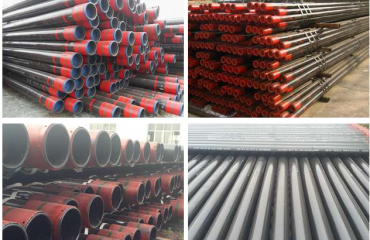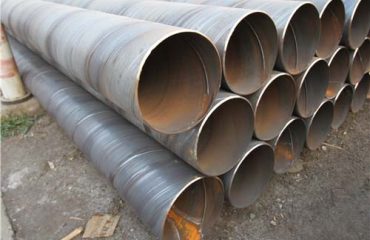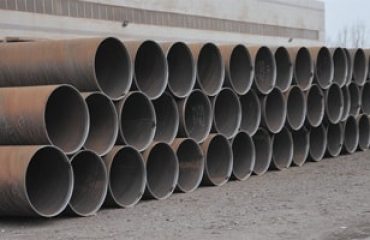
ASTM A671 CC60 CL22 S2 (-46°C) NACE MR0175 LSAW Steel Pipe 1066.8 x 12.7 mm
Introduction to ASTM A671 CC60 CL22 S2 (-46°C) NACE MR0175 LSAW Steel Pipe
ASTM A671 CC60 CL22 S2 (-46°C) NACE MR0175 LSAW steel pipe is a high-quality electric-fusion-welded (EFW) carbon steel pipe designed for high-pressure service at atmospheric and lower temperatures, particularly in demanding environments like oil and gas transmission. With an outer diameter of 1066.8 mm (42 inches) and a wall thickness of 12.7 mm, this longitudinal submerged arc welded (LSAW) pipe is manufactured from ASTM A516 Grade 60 pressure vessel plates, ensuring excellent toughness and weldability. The CL22 designation indicates normalizing heat treatment and radiographic examination, while the S2 supplementary requirement ensures low-temperature impact toughness at -46°C. Compliance with NACE MR0175 guarantees resistance to sulfide stress cracking (SSC) in sour service environments, making it ideal for harsh conditions.
The pipe’s robust mechanical properties, including a minimum yield strength of 220 MPa and tensile strength of 415–550 MPa, combined with its corrosion resistance, make it suitable for applications such as main transmission trunk lines, boiler piping, and petrochemical pipelines. Its cost-effectiveness, compared to high-performance alloys like Inconel® 718, and its ability to perform in low-temperature and corrosive settings, position it as a reliable choice for critical infrastructure. This article provides a detailed exploration of the pipe’s chemical composition, mechanical properties, manufacturing processes, corrosion resistance, applications, and dimensional tolerances, with comprehensive tables summarizing key parameters. Comparisons with Inconel 718, Incoloy 901, and API 5L X70 highlight its specialized role in industrial applications.
Chemical Composition and Material Analysis
The chemical composition of ASTM A671 CC60 CL22 S2 pipe, based on ASTM A516 Grade 60 plates, is tailored for strength, toughness, and weldability in low-temperature environments. The typical composition includes carbon (0.04–0.27%), manganese (0.85–1.20%), phosphorus (≤0.025%), sulfur (≤0.025%), silicon (0.15–0.40%), and trace amounts of aluminum (≥0.02%) for deoxidation. These elements ensure a stable microstructure with minimal inclusions, enhancing the pipe’s performance in sour service per NACE MR0175. The low carbon content reduces the risk of weld imperfections, while manganese improves strength and toughness. Phosphorus and sulfur are tightly controlled to prevent embrittlement, critical for low-temperature impact resistance at -46°C.
Compared to Inconel 718 (50–55% nickel, 17–21% chromium, 4.75–5.50% niobium), ASTM A671 CC60 contains significantly less alloying elements, relying on carbon and manganese for strength rather than nickel-based precipitation hardening. Incoloy 901 (40–45% nickel, 2.35–3.10% titanium) also has a higher alloy content, offering superior corrosion resistance but at a higher cost. Relative to API 5L X70 (0.26% carbon, 1.65% manganese), ASTM A671 CC60 has a lower carbon equivalent (CEV ≤0.43%), improving weldability but offering slightly lower yield strength (220 MPa vs. 485 MPa). The NACE MR0175 compliance ensures hardness ≤22 HRC and controlled microstructure to resist SSC, a critical requirement for sour gas pipelines. This composition balances cost and performance, making the pipe suitable for large-diameter, high-pressure applications.
Mechanical Properties
The mechanical properties of ASTM A671 CC60 CL22 S2 pipe are optimized for low-temperature, high-pressure applications. The minimum yield strength is 220 MPa (32 ksi), with a tensile strength of 415–550 MPa (60–80 ksi) and elongation of ≥27% for wall thicknesses ≤25 mm, per ASTM A516 Grade 60. The S2 supplementary requirement mandates Charpy V-notch impact testing at -46°C, with minimum energy absorption of 14 J (single) and 18 J (average) for the weld centerline, heat-affected zone (HAZ), and base metal, ensuring toughness in cold environments. The normalizing heat treatment (CL22) at 850–950°C, followed by air cooling, refines the grain structure, eliminating residual stresses and enhancing low-temperature performance.
Compared to Inconel 718 (yield strength 1035 MPa, tensile strength 1275 MPa), ASTM A671 CC60 offers lower strength but is more cost-effective for structural applications. Incoloy 901 (yield strength ~900 MPa) provides higher strength than CC60 but is less suited for low-temperature sour service. API 5L X70 (yield strength 485 MPa, tensile strength 570 MPa) outperforms CC60 in strength but lacks the same low-temperature toughness and NACE compliance without additional processing. The pipe’s weld undergoes tension and transverse guided bend tests per ASTM A671, ensuring integrity under pressure. These properties make ASTM A671 CC60 CL22 S2 ideal for pipelines in cold climates and corrosive environments, offering a balance of toughness, strength, and affordability.
Corrosion Resistance and NACE MR0175 Compliance
ASTM A671 CC60 CL22 S2 pipe is designed for moderate corrosion resistance, enhanced by NACE MR0175 compliance for sour service environments containing hydrogen sulfide (H2S). The low carbon and sulfur content, combined with a controlled microstructure (hardness ≤22 HRC), minimize susceptibility to sulfide stress cracking (SSC) and hydrogen-induced cracking (HIC). The pipe’s surface can be coated with epoxy (EP), polyethylene (PE), polypropylene (PP), fusion-bonded epoxy (FBE), or anti-corrosion oil to enhance resistance to external corrosion in soil or marine settings. Galvanizing or varnishing is also possible, though less common for large-diameter pipes.
Unlike Inconel 718, which excels in chloride-rich and high-temperature corrosive environments due to its 50–55% nickel and 2.8–3.3% molybdenum, ASTM A671 CC60 relies on coatings for corrosion protection, as its carbon steel base is less inherently resistant. Incoloy 901 offers better corrosion resistance than CC60 but is not typically NACE-compliant without specific processing. API 5L X70 pipes, used in similar applications, require coatings like 3LPE for corrosion resistance, similar to CC60, but may not meet NACE MR0175 hardness requirements without additional controls. The pipe’s ability to operate in sour gas pipelines, combined with its low cost compared to nickel alloys, makes it a practical choice for oil and gas applications where moderate corrosion resistance is sufficient with proper protection.
Manufacturing and Processing
The manufacturing of ASTM A671 CC60 CL22 S2 LSAW steel pipe involves electric-fusion-welding with filler metal, using ASTM A516 Grade 60 plates. The LSAW process entails rolling plates into a cylindrical shape, followed by longitudinal submerged arc welding (SAW) on both internal and external surfaces to ensure a robust seam. The weld is reinforced and cleaned using scarfing blades, ensuring dimensional accuracy and a smooth finish. Normalizing heat treatment (CL22) at 850–950°C, followed by air cooling, is applied to the entire pipe, including welds and HAZ, to eliminate residual stresses and enhance low-temperature toughness. The S2 requirement mandates impact testing at -46°C, verifying performance in cold conditions.
The pipe undergoes 100% radiographic testing (RT) per CL22 to detect weld imperfections, along with hydrostatic, ultrasonic, or eddy current testing to ensure integrity. NACE MR0175 compliance involves controlling hardness and microstructure through heat treatment and material selection. Compared to Inconel 718, which requires vacuum melting and complex heat treatments (e.g., solution annealing at 1038°C), ASTM A671 CC60 is simpler to produce, reducing costs. Incoloy 901 and API 5L X70 pipes also involve simpler processes than Inconel 718 but may require additional testing for sour service. The pipe’s dimensions (1066.8 mm OD, 12.7 mm WT) are achieved with precise rolling and welding, meeting ASTM A671 tolerances for large-diameter applications.
Applications
ASTM A671 CC60 CL22 S2 (-46°C) NACE MR0175 LSAW steel pipe is widely used in industries requiring reliable performance at low temperatures and in sour service environments. Its primary applications include main transmission trunk lines for oil and gas, large station communication pipelines, boiler inlet and outlet pipes, and floating production storage and offloading (FPSO) module piping. The pipe’s low-temperature toughness at -46°C makes it suitable for cold climates, while NACE MR0175 compliance ensures durability in H2S-containing environments like sour gas wells. Its large diameter (1066.8 mm) and moderate wall thickness (12.7 mm) support high-pressure fluid transport in petrochemical, thermal power, and gas transmission industries.
Unlike Inconel 718, used in high-temperature aerospace and sour gas applications (e.g., jet engine components), ASTM A671 CC60 is optimized for low-temperature, cost-sensitive projects. Incoloy 901, employed in similar high-stress environments, lacks the low-temperature focus of CC60. API 5L X70 pipes are used in similar pipeline applications but may not meet the same low-temperature or NACE requirements without customization. The pipe’s versatility, with end finishes like beveled, plain, or threaded, and coatings like FBE or 3LPE, enhances its adaptability for water, oil, and gas transmission, making it a preferred choice for infrastructure projects in harsh environments.
Dimensional Tolerances
Dimensional tolerances for ASTM A671 CC60 CL22 S2 LSAW steel pipe are governed by ASTM A671, ensuring precision for large-diameter applications. For a pipe with an outer diameter of 1066.8 mm (42 inches), the tolerance is ±0.5% of the specified OD (approximately ±5.33 mm). The wall thickness tolerance for 12.7 mm is ±12.5% (approximately ±1.59 mm), ensuring consistent strength. Straightness deviation is limited to 0.2% of the pipe length, critical for long pipelines. The pipe’s circumference tolerance is ±0.5% of the specified OD, and weight tolerance is ±10%, ensuring uniformity in large-scale projects.
Compared to Inconel 718 forgings (ASTM B637: ±0.25 mm for small diameters), ASTM A671 CC60 has looser tolerances due to its larger size and structural focus. Incoloy 901 forgings follow similar precision standards to Inconel 718, while API 5L X70 pipes (API 5L: ±0.75% OD, ±10% WT) have slightly tighter OD tolerances but comparable wall thickness tolerances. Weld seam height is controlled to ensure a smooth finish, and end finishes (e.g., beveled) meet ASME B16.25 standards. These tolerances ensure reliable installation and performance in applications like gas transmission pipelines, where dimensional accuracy is critical.
Technical Specifications and Parameter Table
The following table summarizes the key parameters of ASTM A671 CC60 CL22 S2 (-46°C) NACE MR0175 LSAW steel pipe (1066.8 x 12.7 mm), providing a reference for engineers.
| Parameter | Specification |
|---|---|
| Standard | ASTM A671 / ASME SA671 |
| Grade | CC60 CL22 S2 |
| Material | ASTM A516 Grade 60 |
| Outer Diameter | 1066.8 mm (42 inches) |
| Wall Thickness | 12.7 mm |
| Chemical Composition | C: 0.04–0.27%, Mn: 0.85–1.20%, P: ≤0.025%, S: ≤0.025%, Si: 0.15–0.40%, Al: ≥0.02% |
| Yield Strength (Min) | 220 MPa (32 ksi) |
| Tensile Strength | 415–550 MPa (60–80 ksi) |
| Elongation (Min) | ≥27% (≤25 mm WT) |
| Impact Test (S2) | -46°C, 14 J (single), 18 J (average) for weld, HAZ, base metal |
| Heat Treatment | Normalizing at 850–950°C, air cooled (CL22) |
| NACE MR0175 | Hardness ≤22 HRC, SSC resistance |
| Welding Method | LSAW (Submerged Arc Welding) |
| Testing | 100% RT, hydrostatic, ultrasonic, tension, bend tests |
| Coatings | EP, PE, PP, FBE, anti-corrosion oil, galvanizing, varnishing |
| End Finishes | Beveled, plain, threaded, coupled |
| Applications | Oil/gas pipelines, boiler piping, petrochemical, FPSO modules |
This table provides a concise overview of the pipe’s specifications, aiding in design and procurement decisions.
Comparison with Inconel 718, Incoloy 901, and API 5L X70
ASTM A671 CC60 CL22 S2 differs significantly from Inconel 718, Incoloy 901, and API 5L X70 in composition, properties, and applications. Inconel 718 (yield strength 1035 MPa, 50–55% nickel) excels in high-temperature, corrosive environments like aerospace and sour gas wells, offering superior corrosion resistance but at a significantly higher cost. ASTM A671 CC60 (yield strength 220 MPa) is optimized for low-temperature, cost-sensitive applications, relying on coatings for corrosion protection. Incoloy 901 (yield strength ~900 MPa, 40–45% nickel) provides high strength and corrosion resistance for aerospace but lacks the low-temperature toughness and NACE compliance of CC60 without customization.
API 5L X70 (yield strength 485 MPa, tensile strength 570 MPa) is used in similar pipeline applications, offering higher strength than CC60 but potentially lower low-temperature toughness and NACE compliance unless specifically processed. ASTM A671 CC60’s normalizing and S2 testing ensure superior performance at -46°C, while its lower CEV enhances weldability compared to X70. The choice depends on project requirements: Inconel 718 for extreme corrosion and temperature, Incoloy 901 for high-strength aerospace, API 5L X70 for high-pressure pipelines, and ASTM A671 CC60 for cost-effective, low-temperature sour service.
Challenges and Limitations
Despite its advantages, ASTM A671 CC60 CL22 S2 pipe faces challenges. Its carbon steel base requires coatings to resist external corrosion, unlike Inconel 718’s inherent resistance. In sour service, strict adherence to NACE MR0175 hardness and microstructure controls is critical to prevent SSC, requiring precise heat treatment and testing. The LSAW process, while cost-effective for large diameters, demands high-quality welding to avoid defects, with 100% RT adding to production costs. Low-temperature performance at -46°C is robust, but applications below this temperature may require alternative grades like ASTM A671 CC65 or CC70.
Compared to API 5L X70, ASTM A671 CC60 has lower strength, limiting its use in ultra-high-pressure pipelines. Inconel 718 and Incoloy 901, while stronger, are prohibitively expensive for large-scale infrastructure. Installation of large-diameter pipes (1066.8 mm) requires specialized equipment, and field welding must maintain NACE compliance. These challenges are mitigated through advanced coatings, rigorous quality control, and proper design, ensuring the pipe’s reliability in demanding applications like gas transmission and petrochemical processing.
Future Trends and Innovations
The future of ASTM A671 CC60 CL22 S2 LSAW steel pipe is shaped by advancements in manufacturing, coatings, and sustainability. Innovations in submerged arc welding and real-time weld monitoring are improving seam quality, reducing defects, and lowering costs. Research into advanced coatings, such as nanotechnology-based FBE and 3LPE, is enhancing corrosion resistance, extending service life in harsh environments. The integration of digital tools, like predictive maintenance and pipeline monitoring, is improving operational efficiency and safety in oil and gas applications.
The growing demand for energy infrastructure, particularly in cold climates and sour gas fields, is driving the use of NACE-compliant pipes like ASTM A671 CC60. Sustainable practices, such as using recycled steel and low-carbon production methods, are aligning with environmental goals. Compared to Inconel 718 and Incoloy 901, which are exploring additive manufacturing for complex parts, ASTM A671 CC60 focuses on cost-effective scalability for large-diameter pipelines. As global energy transitions accelerate, this pipe will remain a critical component, supporting reliable and sustainable fluid transport in challenging conditions.
Conclusion
ASTM A671 CC60 CL22 S2 (-46°C) NACE MR0175 LSAW steel pipe (1066.8 x 12.7 mm) is a robust, cost-effective solution for high-pressure, low-temperature applications in sour service environments. Its chemical composition, based on ASTM A516 Grade 60, ensures weldability and toughness, while normalizing (CL22) and impact testing at -46°C (S2) guarantee performance in cold climates. NACE MR0175 compliance ensures resistance to SSC, making it ideal for oil and gas pipelines, boiler piping, and petrochemical applications. The LSAW process and rigorous testing (100% RT, hydrostatic) ensure reliability for large-diameter infrastructure.
Compared to Inconel 718 and Incoloy 901, ASTM A671 CC60 offers lower strength and corrosion resistance but excels in cost-sensitive, low-temperature applications. Relative to API 5L X70, it provides superior low-temperature toughness and NACE compliance. The detailed parameter table and dimensional tolerances provided serve as a valuable resource for engineers. Future innovations in welding, coatings, and sustainability will enhance its performance, ensuring its role in critical infrastructure. ASTM A671 CC60 CL22 S2 remains a testament to the balance of performance, affordability, and reliability in modern engineering.




You must be logged in to post a comment.